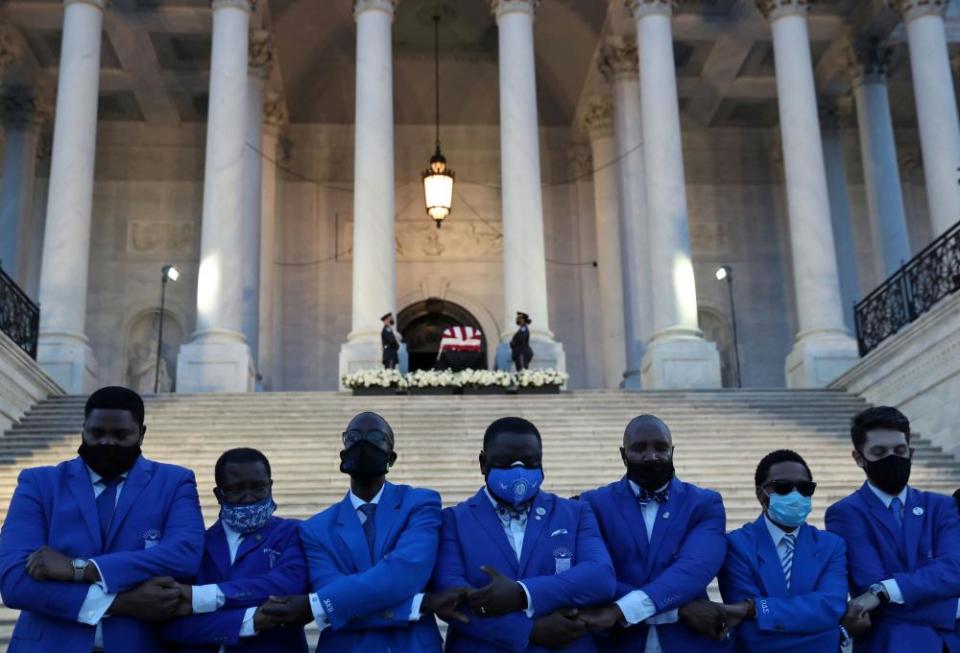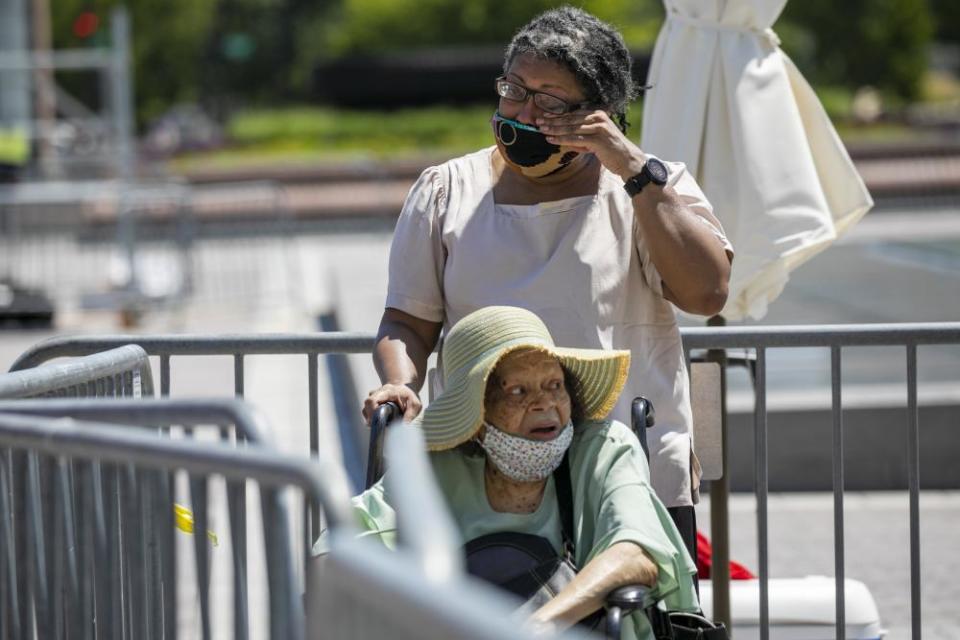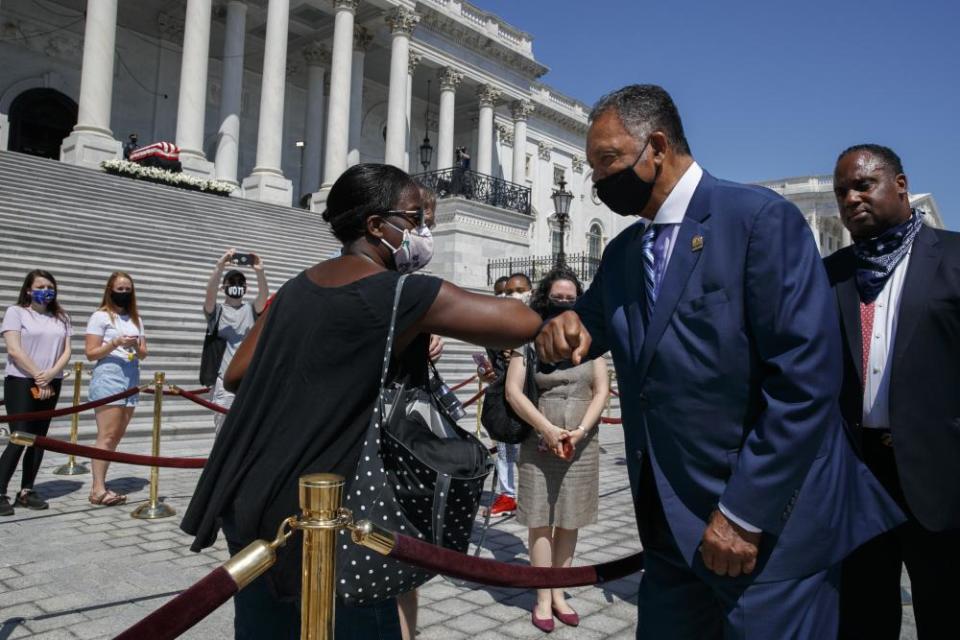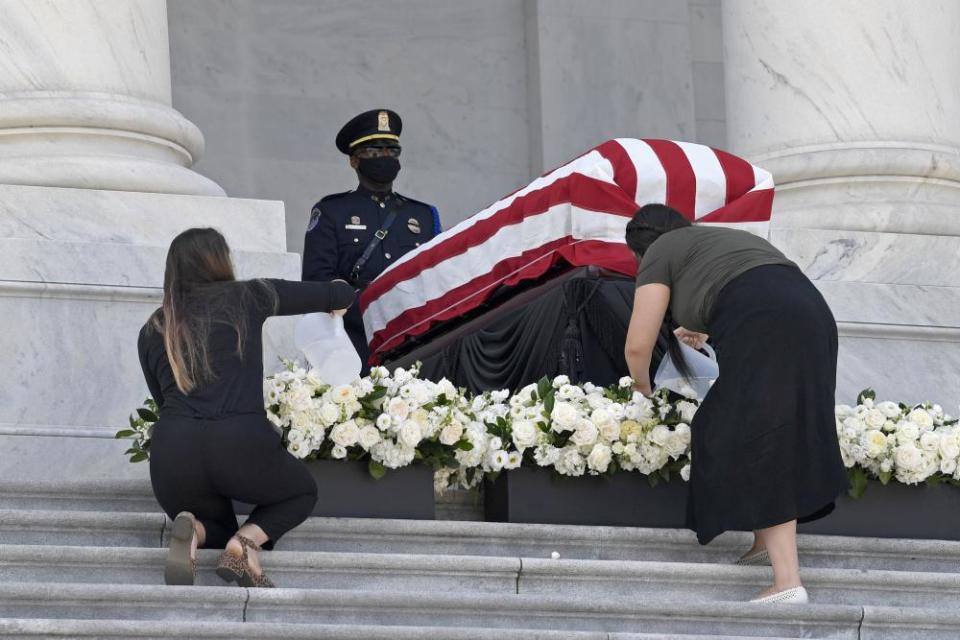'He never yielded': mourners pay respects to John Lewis outside Capitol

Born in Citronelle, Alabama, in the early 1950s, Frankie Blevins grew up with the cruelties imposed by the Jim Crow south: racially segregated drinking fountains, restrooms and restaurants.
On her family’s first road trip, her mother packed food to sustain them for the entire trip, knowing they would not be allowed to stop for provisions along the way.
Related: John Lewis: voice of civil rights leader rings out one final time at lying-in-state
And on 7 March 1965, Blevins vividly recalls watching news coverage of a young John Lewis walking alongside those leading civil rights marchers across the Edmund Pettus Bridge in Selma, Alabama, into a phalanx of white state troopers wielding clubs and bullwhips, on a day that would be remembered as Bloody Sunday.
Standing outside the US Capitol building Tuesday, where Lewis now lies in state following his death this month, Blevins told the Guardian: “My life today is so much more livable in this nation because of what he and others did.”
She had watched on TV all those decades ago, when, ordered to disperse from the bridge, the protesters refused and the troopers advanced, weapons raised in a hail of teargas. Lewis, in the vanguard, had his skull fractured by a trooper’s blow.

Eight days later, President Lyndon Johnson introduced the Voting Rights Act, the landmark civil rights legislation. He signed it into law on 6 August.
After learning of his death, Blevins decided to fly to Washington from Charleston, South Carolina, where she lives, to see him honored among, as House Speaker Nancy Pelosi described it, the “pantheon of patriots.” She wiped her eyes as she looked toward Lewis’s casket, raised on the same catafalque where Abraham Lincoln once rested, she said: “I could not let this moment go by without being there.”
She was among thousands of members of the public who came to the Capitol on Tuesday to pay tribute to the son of sharecroppers who would be remembered as a civil rights icon and the “conscience of Congress”.
Traditionally, visitors would be welcomed into the Capitol to bid farewell. But the public has been prevented from entering buildings in the complex since March, because of the coronavirus.
Instead, Lewis’s coffin was placed outside the Capitol, atop the center steps that lead to the domed rotunda, on Monday evening and all day Tuesday. Above his casket, an American flag flew at half-staff.
Lewis, who was diagnosed with pancreatic cancer in December, died on 17 July, at the age of 80. He is only the second black lawmaker to lie in state in the Capitol, and the first to lie in state in the rotunda.

All those who came to pay their respects on Tuesday wore masks, as required. Some face coverings carried messages: “Black Lives Matter” or “Good Trouble” – one of Lewis’s favorite expressions, which encouraged people to stand up to discrimination and injustice. Social distancing was enforced between visitors as they wended their way to the base of the Capitol steps.
The Lewis family requested the public offer tributes online using the dedicated hashtags #BelovedCommunity or #HumanDignity, rather than risk their health traveling from out of town. But those who came said they felt compelled.
“As African Americans, I believe he was one of our forefathers,” said Tasha Burks, who came with her son from Virginia. “He led that march for us to have the freedoms that we have now. He walked the walk and talked the talk. Someone like that you have to come out and pay your respects in person.”
More than half a century after Lewis was beaten by a mob as a Freedom Rider, defying segregation of interstate bus services, and marched in Selma, young people are again marching in the streets.
Related: John Lewis crosses Edmund Pettus Bridge in Selma for final time
Lewis encouraged the Black Lives Matter movement, whose supporters demand racial equality in nationwide protests sparked by the killing of George Floyd, a black man who died under the knee of a white Minneapolis police officer in May. Those who came pondered the progress that had been made since then – and how best to honor his legacy.
“I’m encouraging people to keep marching and to continue to be hopeful,” said Alysia Dempsey, an author based in Washington. She then pointed to her shirt, which read: “The best way to protest is to vote.”
The viewing was part of a processional of public remembrances that started in Alabama and will end this week in Georgia, the state Lewis represented in Congress.
On Sunday, a horse-drawn carriage carried his flag-draped casket over the Edmund Pettus Bridge. Red rose petals blanketed the four-lane stretch of road suspended above the Alabama River, where Lewis once bled.

The casket was placed in the Capitol rotunda on Monday as political leaders of both parties paid their respects, though without Donald Trump, who declined to attend.
On Tuesday, despite high summer heat, a steady stream of visitors placed their hands on their hearts or bowed their heads as they paused at the foot of the Capitol.
Some had personal recollections of the congressman,his unwavering courage and his relentless optimism, his quiet presence and his thundering oratory.
Rocky Twyman, who is leading a campaign to nominate Lewis for a Nobel peace prize, said he had marched alongside him in Atlanta in the 1960s. Twyman recalled Lewis as a mentor to the next generation of civil rights organizers. He said he hoped Lewis’s legacy of non-violent opposition would continue to shape the movement for racial equality.
“He never fought back. He never yielded to it,” said Twyman, who wore a tie-dyed T-shirt with the words “Black Lives Matter”. “He was a towering figure, a civil rights icon, but he was always willing to talk to the young people. That’s what I loved about him.”
Two onlookers held signs urging Congress to honor Lewis’s legacy by passing legislation that would restore a key provision of the Voting Rights Act, which was renamed in the late congressman’s honor this week.
The marquee sign outside of the United Methodist Building, across the street from the Capitol, said: “In memory of Rep John Lewis. Hope. Act. Vote.”
Some knew Lewis only from history books and movies but were moved all the same.
“My heart is heavy right now because what happened to him in the 50s and 60s is happening right now, today,” said Kelly Pete, a lifelong resident of DC. “It’s like history is repeating itself.”
Pete, who is black, believed Donald Trump had exacerbated these problems, accusing him of fomenting hate and inflaming racial tensions.
Though she worried about the world that her grandchildren will grow up in, Pete remained hopeful, as Lewis preached.
“They won’t win,” she said of the forces opposed to racial equality. “God don’t like ugly.”

 Yahoo News
Yahoo News 